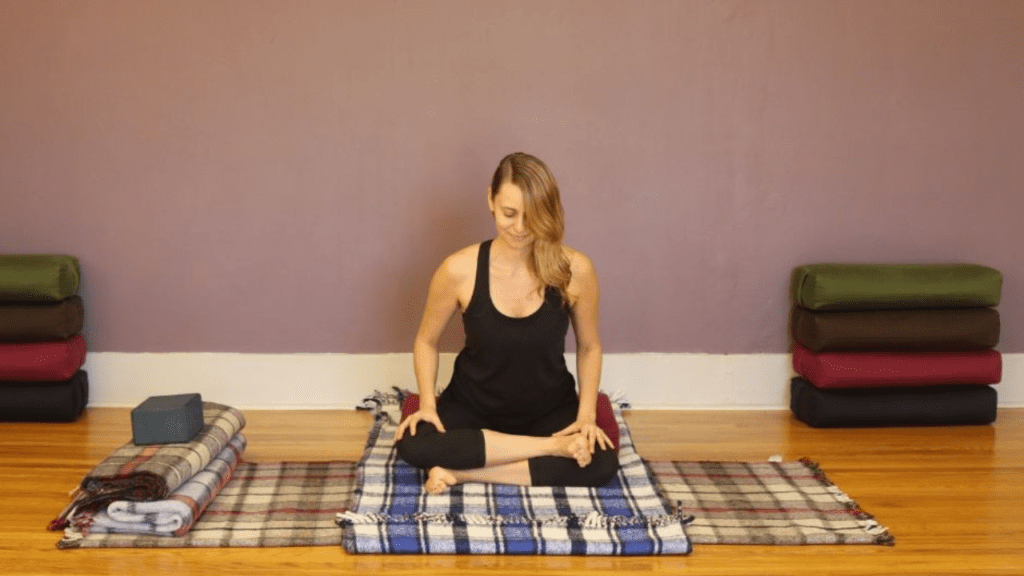Welcome to the area of Square Pose Yoga, a serene practice that invites tranquility and flexibility into your existence. Known as Sukhasana in conventional yoga, this simple yet profound pose is a gateway to better meditation and strain comfort. Ideal for beginners of each age, Square Pose permits organizing the hips, lengthening the backbone, and calming the mind. Let’s dive into how this pose can benefit you and a manner to carry out it effectively.

What is Square Pose Yoga?
Square Pose, or Sukhasana, is frequently used as a starting function for meditation and respiration physical activities in yoga. This seated pose includes crossing your legs so that your shins form a rectangular. While it seems honest, the pose is robust in its capability to foster inner peace and physical balance.
Benefits of Practicing Square Pose
Square Pose offers several blessings, making it a favorite amongst yoga practitioners of all tiers. Here are some extra advantages:
- Enhances Digestive Health: The upright, open feature of the torso can facilitate better digestion.
- Reduces Physical Tension: Regular practice permits relief of tension within the lower back, neck, and shoulders.
- Improves Circulation: Sitting upright in this pose promotes higher blood flow in the course of the frame.
- Enhancing Flexibility: It stretches the knees, ankles, and hips.
- Improving Posture: Encourages a direct spine, this is vital for correct posture.
- Promoting Inner Peace: Reduces pressure and tension, promoting a peaceful mind.
Preparing for Square Pose
Before you start, ensure you’re sporting cushy clothing and feature a yoga mat or a gentle floor to sit down on. It’s beneficial to perform some warm-up stretches for the hips and legs to make the pose greater comfortable.
Curious about more yoga poses? Check out our detailed guide on “Bird Yoga Pose” for another enriching addition to your practice!
Step-by-Step Guide to Square Pose
- Starting Position: Sit on the ground with your legs extended in front of you.
- Cross Your Legs: Bend your knees and move your legs on the shins, setting each foot below the alternative knee.
- Position Your Hands: Place your palms on your knees or your lap.
- Straighten Your Spine: Sit up tall, and imagine a string pulling your head closer to the ceiling.
- Relax Your Shoulders: Keep your shoulders comfortable and far from your ears. Allow your frame to experience grounded even as preserving an alert posture, which enhances the meditative component of the pose.
Adjustments and Modifications
If you discover the pose uncomfortable, you could make adjustments consisting of:
- Placing a cushion or folded blanket under your sit-down bones.
- Using a block beneath every knee for assistance if they do now not effortlessly attain the floor.
- Gently pulling in your stomach to help the decrease lower back, enhancing middle engagement for higher stability.
Common Mistakes to Avoid
Avoid those not-unusual errors to get the most out of your Square Pose:
- Slouching or rounding the lower back, could position undue stress on the spine.
- Straining the neck or shoulders, which ought to remain comfortable to maximize advantages.
- Forcing the knees down to the ground can result in joint pressure. Allow your body to adapt to the pose certainly over time.
Integrating Breathing Techniques
Breathing deeply in Square Pose complements its advantages. Focus on sluggish, deep breaths to assist calm the mind and relax the frame.
Incorporating Square Pose into Daily Routine
Square Pose is ideal for integrating into your everyday ordinary. You can exercise it:
- As a meditation pose in the morning or evening.
- When taking breaks from work or take a look at to relieve anxiety.
Curious about more yoga poses? Check out our detailed guide on “Figure 4 Yoga Pose” for another enriching addition to your practice!
Advanced Variations for Experienced Practitioners
As you get comfortable with the basic pose, attempt these versions:
- Elevate the pose by placing the hands overhead.
- Intensify the stretch by leaning ahead, and keeping the back straight.
Safety and Precautions
While Square Pose is commonly secure, avoid or modify it when you have severe knee or hip issues. Always listen to your frame and discuss with a healthcare issuer when you have issues.
The Role of Square Pose in Modern Yoga Practices
Square Pose isn’t always only a newbie’s workout; it’s also central to advanced yoga practices concerning meditation and pranayama (breath manipulation).
Curious about more yoga poses? Check out our detailed guide on “Yoga Pose Candle” for another enriching addition to your practice!
Conclusion
- Simple and Effective: Square Pose is an on-hand yoga pose appropriate for every age.
- Flexibility and Calm: It allows for improving flexibility and lowering pressure.
- Daily Practice: Easily integrates into day-by-day routines for lasting benefits.
Embrace the simplicity and profound blessings of Square Pose to decorate your yoga exercise and produce a feeling of calm and flexibility in your lifestyle.